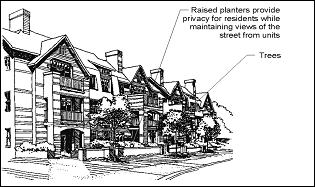22.42.070 Multifamily residential design standards.
A. Purpose. The purpose of these standards is to address site-specific design elements for multifamily developments to ensure that multifamily units have an appropriate relationship to the street, open spaces, and other amenities intended to serve residents.
B. Multifamily residential buildings, where allowed, must be oriented toward a public street rather than parking areas or adjacent properties. The siting and frontage design of multifamily buildings shall address the following standards:
1. When fronting an improved right-of-way, the primary building entry and/or individual building entries shall face the improved right-of-way.
2. Buildings shall provide windows that face the street to provide “eyes on the street” for safety.
3. Where the orientation of the lot makes the requirement in this subsection (B) infeasible, the structure shall:
a. Front the access tract to the site;
b. Provide architecture details to the portion of the building fronting the improved right-of-way, such as porches, landscape screening, and common areas.
Figure 22.42.070. Appropriate Street-Front Treatments for Multifamily Uses

4. Buildings containing street level residential uses shall be set back from the sidewalk a minimum of ten feet and feature substantial landscaping between the sidewalk and the building. Maintaining views, however, between the dwelling units and the sidewalk is important for safety.
C. Building design must modulate at least every thirty feet along public streets. Building modulations must step back the building wall back or forward at least four feet. The minimum depth of modulation shall be eighteen inches and width is four feet if tied to a change in color, building material and/or roofline modulation; otherwise, the minimum depth is ten feet and minimum width is fifteen feet.
D. Modulation can be achieved by an offset in the building foundation, projecting window bays, connecting an open porch to the building, a dormer facing the street, a variety of roof forms, a well-defined entry element, or other features that provide architectural variation and reduce the bulk and mass of a multifamily building.
E. Dormers or intersecting rooflines shall be used to break up continuous sloped roofs.
F. Shared Garages and Driveways.
1. Shared garages are permitted in the R15, R25, MN, and MG zoning districts.
2. Each housing unit shall be assigned a garage space and may share the structure with other homes.
3. Shared detached garages shall not exceed forty-four feet in width and shall maintain a minimum eight-foot separation from adjacent dwellings. Where occupiable space is permitted above a shared garage, a maximum width of fifty feet shall be permitted to allow for stair access.
G. On-Site Recreation.
1. On-site recreation space shall be required for multifamily residential development that is subject to the provisions of this chapter and containing seven or more dwelling units.
2. On-site recreation space shall be provided in accordance with the following table:
|
Type of Dwelling Unit |
On-Site Recreation Open Space Required per Each Dwelling |
|---|---|
|
Studio and one bedroom |
90 square feet per unit |
|
Two bedrooms |
130 square feet per unit |
|
Three or more bedrooms |
170 square feet per unit |
3. Open space should be oriented to receive sunlight by facing east, west, or south when possible.
4. On-site recreation open space shall be designed as follows:
a. On-site recreation open space shall be located in a separate tract for subdivisions and short subdivisions from the residential dwellings and shall have an undivided ownership interest by owners of the development;
b. Balconies may count toward fifty percent of the open space requirement;
c. At least forty percent of the total required on-site recreation open space shall be consolidated in one location within the development with no dimension less than fifteen feet and may not include fenced yards or balconies serving a single dwelling unit;
d. At least seventy-five percent of the total required on-site recreation open space shall be located outside of critical areas other than buffers identified in Chapter 22.80 MMC, Critical Areas;
e. No on-site recreation open space tract shall contain less than seven hundred square feet in area;
f. On-site recreation open space shall be developed for active and passive uses. At least fifty percent of the on-site recreation open space shall be designed and improved for one or more active uses. When an area of on-site recreation open space is designed and improved for active uses other than improved pedestrian or bicycle paths with hard surfaces, the average width of the area shall be at least equal to half of the average length of the area. Active uses include, but are not limited to:
i. Playgrounds developed with children’s play equipment;
ii. Improved pedestrian or bicycle paths with hard surfaces;
iii. Sports fields (such as soccer or softball fields), with associated improvements;
iv. Indoor or outdoor sports courts (such as volleyball, basketball or tennis courts), swimming pools, and similar facilities;
v. Picnic areas with permanent tables, benches or gazebos;
vi. Community clubhouse and meeting facilities;
vii. Community gardens for use by the residents; and
viii. Plazas with lighting, artwork, and sitting space for pedestrians at four or more spaces for every required one hundred square feet of area.
g. Passive uses include critical areas that cannot be developed, nature interpretive areas, bird watching facilities, unimproved trails, and similar uses approved by the zoning administrator;
h. The following drainage facilities may be counted as on-site passive recreation space:
i. Unfenced detention, retention and wet ponds;
ii. Storm water treatment wetlands;
iii. Storm water infiltration trenches and bioswales that serve more than one dwelling; and
iv. Vegetated areas located above underground detention facilities.
i. Access for pedestrians shall be provided from all dwellings within the development to the on-site recreation space through trails, sidewalks, pathways and other similar means of access. (Ord. 005/2019 § 10 (Exh. B))